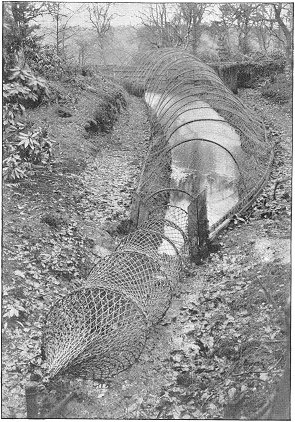A duck decoy is a small pond with often six edges and six long cone-shaped wickerwork tunnel, used to catch wild ducks. After the ducks settled, a small trained dog would herd the ducks into the tunnel. The catch was formerly sent to market in Ribe, Copenhagen and Hamburg or to the restaurants on board the atlantic steam ships, but since 1931 decoying in Denmark is forbidden by law. In the 1970th and '80th decoys were used to catch ducks to be ringed and released.
Of all the contrivances invented by the ingenuity of man for the capture of wildfowl, I think a Duck decoy is at once the most interesting and the most deadly. The first one made, and worked by enticing the birds into it, in this country was, it is believed, that constructed by Charles II in St James's Park.
Some idea may be gathered of the effective nature of this engine of destruction when it is mentioned that about a century ago no less than 31,000 wildfowl of various species were taken in a single season by ten Lincolnshire decoys.
The precision of modern firearms and the great increase of gunners of all kinds have almost reduced decoying to a lost art. However, there are still a few pipes, as the contrivances are called, worked in different parts of the country; and the man who looks after those I am about to describe - three in number - succeeded last winter in killing 1,500 head of wildfowl, despite the fact that he was not working upon an ideal piece of water, and was continually harassed by a number of flight shooters, who waited for his birds in some adjoining property, over which he had no control, and blazed off at them almost every morning and evening, as they came in from and left again for the mud flats by the sea.
Successful Duck-decoying can only be carried on by the fortunate combination of several important essentials. 1) Perfect quietness upon the body of water, large or small, to which the birds come to spend the day. 2) A good set of well-kept pipes, each trending to a cardinal point of the compass, for it is absolutely necessary when a pipe is worked that the wind shall be blowing from the tail of it; for ducks always swim and fly with their heads to the wind. The pipes are, for this reason, named from the direction in which they point. 3) A well-trained, intelligent dog of small size, quick action, and silent habits. If it resembles a fox in colour so much the better, but this qualification is not now considered so essential as it was in olden times, when the decoy-men attached so much importance to it that they tied the skin of a fox on to a dog's back, and allowed the brush to trail upon the ground. 4) A number of well-trained lure Ducks that will come to the decoy-man's whistle or the sight of his dog, and swim steadily up the pipe; and last, and most important of all, a man of more than average industry, intelligence, and skill.
(From Richard Kearton: 'With Nature and a Camera', 1897).
Read more in English or in Danish translation ...

Decoy pipe from tail end
The pipe is covered by iron hoops, commencing at the mouth with one having a span of from twenty-five to thirty feet, and a height, from the centre of the arch to the water, of something like fifteen feet; the hoops gradually diminishing in size as they approach the tail of the pipe to about two feet in diameter. The whole is covered by a hand-spun hemp net, with a two-inch mesh, well coated with tar and tan. I was assured by the decoy-man that one of these nets will last twenty years. Some pipes are covered by a four-inch mesh at the mouth, and for some distance down, and then one of half the diameter. Photo: Cherry Kearton.
The pipe is covered by iron hoops, commencing at the mouth with one having a span of from twenty-five to thirty feet, and a height, from the centre of the arch to the water, of something like fifteen feet; the hoops gradually diminishing in size as they approach the tail of the pipe to about two feet in diameter. The whole is covered by a hand-spun hemp net, with a two-inch mesh, well coated with tar and tan. I was assured by the decoy-man that one of these nets will last twenty years. Some pipes are covered by a four-inch mesh at the mouth, and for some distance down, and then one of half the diameter. Photo: Cherry Kearton.
Published October 17, 2007. Idea, research and layout: © Per Hofman Hansen - Aldus.dk.